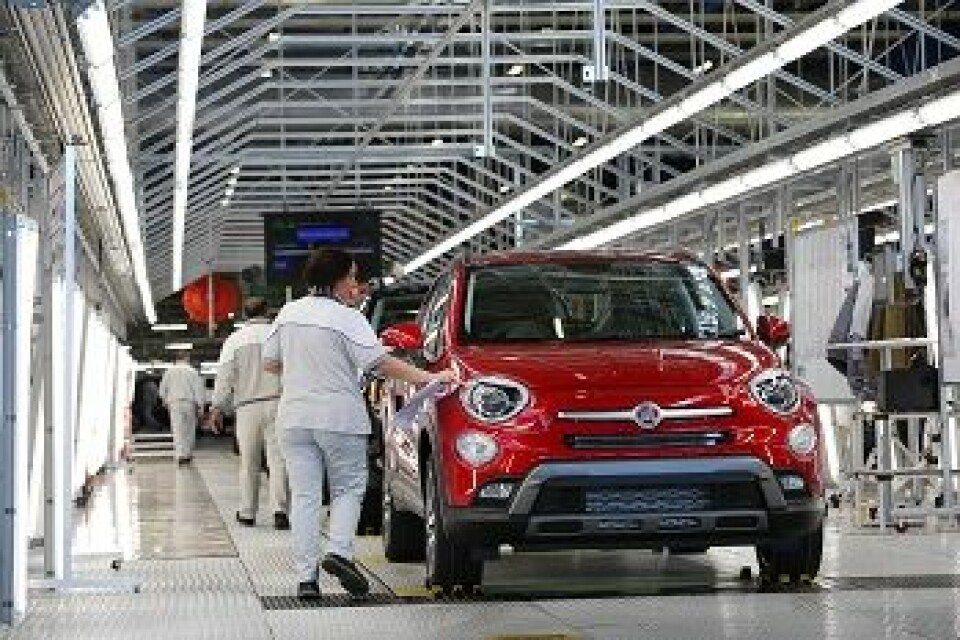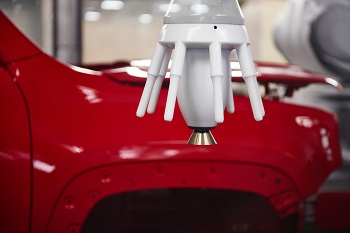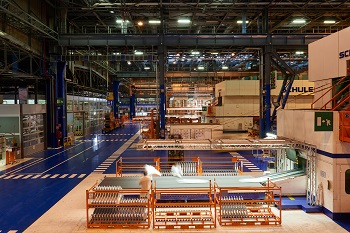The billion euro plant

FCA has invested heavily in its plant at Melfi to create a state-of-the-art production facility
The workforce at Fiat’s Melfi factory gave a huge cheer when, back in 2012, FCA head Sergio Marchionne announced that the ailing plant was to receive a €1 billion (£700 million) investment to make two new models. The two models were related small SUVs – the Fiat 500X and the Jeep Renegade – new entrants into what’s now the fastest growing segment in Europe, if not the world.
The boost was sorely needed. The future of its 8,000 strong workforce together with another 1,000 workers at its attached supplier park was in doubt as production at the plant in southern Italy slumped from a peak of 410,000 seven years previously as demand for its sole model, the Fiat Grande Punto, declined in markets across Europe.
The Jeep Renegade started production first in August last year, followed two months later by the Fiat 500X. The two new models are built on an updated line, one of two originally used for the Grande Punto. The Punto continues to be assembled on the second line with production expected to be just 75-80,000 this year. The 4,000 assembly staff are split 70:30 between the new SUVs and the 10-year-old Punto.

Production of the 500X and Renegade has boosted the fortunes of the Melfi plantGetting close to capacity
The two SUVs are selling well and at the time of writing the plant had made more than 160,000 Renegades and 100,000 500Xs with Melfi forecast to make over 400,000 vehicles in total this year. The factory is running three shifts a day and plant manager Nicola Intrevado reckons the plant is now running close to its capacity, making it the second biggest FCA production facility after Betem in Brazil and the largest for the group in Europe.
The inclusion of Jeep was radical. “The real quantum shift was to start producing for an iconic American brand – to manufacture here for the US is the big challenge,” Intrevado told Automotive Manufacturing Solutions. “Before we were much more linked to and dependent on Italy and Europe.” The Renegade is currently only made in Italy and 60% of the units produced are exported to the US. More than 90% of these are fitted with a 2.4-litre petrol engine that is imported from FCA’s Dundee, Michigan plant. Most of the remaining Renegade production (mainly diesel versions) is for the European market. Jeep’s planned new plant in China is likely to make the model for that region.
Spreading the investment
The €1 billion investment has been spread throughout the plant. The press shop is perhaps the area to gain least from this, but it does have a new automatic discharge facility that uses robots to take stamped parts and put them on the racks, which is a manual process in many other plants. Press shop manager Gianfranco Cinquefiori suggests Melfi is the first in the world to automate this process, which he says can be punishing work for people.
Other new additions are two robots fitted with a blue-light scanner and 3D camera to check for imperfections on the pressed parts. “If you play with the colour and intensity of light you can see flaws you couldn’t normally see, for example deformation, dots or problems with the steel,” he says. FCA estimates they’ve cut 30% of steel usage from the Renegade and 500X compared to an equivalent car built using older methods. Cinquefiori says this has been achieved using stronger, lighter hot-formed steel (pressed in Fiat’s Mirafiori factory in Turin) on crash structures, while more precise pressing has allowed sharper lines and thinner steel on outer panels. He gives the example of the Renegade’s front wing, which is 0.63mm thick compared to 0.73mm on the smaller Punto.
“The real quantum shift was to start producing for an iconic American brand – to manufacture here for the US is the big challenge” – Nicola Intrevado, FCA
Automating the paintshop
The body-in-white welding shop is almost completely new we were told, even if it didn’t form part of our factory tour. There 860 robots make around 5,000 welds to each of the SUVs. However, we were shown the paintshop, which received €45m of the investment according to its manager Raffaele D’Onofrio. He says it is now one of the most automated paintshops anywhere, with 54 robots. All-new booths include underbody sealing (using ABB robots), primer and top-coat. All three models here are given five coats (weighing 3.5kg per car) starting with a rust-coating applied by a cataphoretic process in a 200,000-litre bath.
The paint shop has a capacity of 1,600 cars a day which D’Onofrio says can be increased to 2,000 once they solve a couple of bottlenecks. The two top-coat booths are one such pinch-point, largely because of the demand for the two SUVs, but also because red and yellow are proving more popular than anticipated. Cars painted these flat colours need to be run through the booth twice, resulting in an overall takt time of 90 seconds compared to 60 seconds in assembly. So D’Onofrio is building a third booth and investigating a new process for red and yellow that will require only one pass through the booth.
 Colour changes on the top-coat robots can now be done in 3 seconds, compared to 10 minutes for the old system
Colour changes on the top-coat robots can now be done in 3 seconds, compared to 10 minutes for the old systemChanging colour
Paint changes on the Dürr top-coat robots can now be done in just 3 seconds, compared to 10 minutes for the old system, which had 20 meters of paint pipe to clean vs 15cm for the new system. That means cars can be sent down as they’ve been ordered, rather than in colour batches of 20-30 as before. Each machine is also monitored for its electricity use, important when the electricity bill for the paint shop is more than €50,000 a day.
Half the plant’s 8,000 employees work in Melfi’s 160,000 sq. m assembly hall, with just over 3,000 of those on the Renegade/500X line. The flexibility of this line is important notes assembly manager Ennio Meccia: “We designed from the very beginning to be completely flexible on models, option mixes, engine and transmissions”. FCA says the line could take up to four separate models.
The line workers are helped by touchscreens at each of the 48 stations on the two trim lines. These indicate exactly which model and its specification is next in-line; for example a Jeep Renegade 1.4 for the US market with ‘sinistra’ (left-hand drive). Any unusual options are announced with a loud electronic trumpet fanfare that lets the line-workers know they’ve got something a bit different from the norm, for example a full-length glass roof. The touchscreen also has a button to call the team leader with a problem – if the team leader can’t solve it within 60 seconds, the moving floor carrying the cars stops. That floor was a suggestion from the Punto workers and moving floors are unusual in Italian factories, says Meccia.
[sam_ad id=17 codes='true']Flex decking line
Another big investment into the assembly line was the post-trim shift to a rotating hanging system to transport the cars, giving better access to the vehicle’s underbody. This system from Dürr’s Italian operation CPM, runs into the automated engine marriage line. This caged double-height structure is becoming a common sight at newer FCA plants and is a thing of beauty to watch. This so-called flex decking line takes just 54 seconds to match the body and powertrain, and the accuracy is helped by cameras that measure the position. Arms grasp the front suspension struts below the springs to gently pull them into position and then the car moves off to have the bolts automatically tightened by robots at some of the assembly shop’s 278 automated fastening stations.
Nissan in the UK has been gleefully telling everyone that its half-million production in Sunderland last year was more cars than Italy made in its entirety over the same period. With Melfi likely to produce four-fifths of Sunderland’s total this year, it has put Italy’s once-proud automotive industry well and truly back on the map.
 The welding shop is almost completely new. There 860 robots make around 5,000 welds to each of the SUVs
The welding shop is almost completely new. There 860 robots make around 5,000 welds to each of the SUVsPracticing in the Pilotino
Melfi benefited from what’s now become a key feature of new FCA plants – the Pilotino, or pilot plant. In Melfi this is an 18-station assembly area built in advance of starting the new high-tech SUV line to test out the ergonomics and train those about to work on the real thing. Assembly manager Ennio Meccia calls it a “kind of gym” designed to help improve the efficiency of individual stations. He says workers were actively consulted about improvements that could be made from the old Punto line. The process was started in 2013 when 80 specialists from the plant were sent to Turin and Detroit to study different assembly layouts and make suggestions. FCA made heavy use of simulation and virtual design for the line, to create the right balance between speed and ease of use to raise takt time and keep workers safe and healthy. With the SUV line now up and running the Pilotino is now used to train new staff.
AMS: The plant fell into decline making the Punto, so much so you had to make temporary lay-offs. It now has the highest output of any FCA plant in Europe. What has contributed to the new success?
Nicola Intrevado (NI): This plant was successful before, but in 2013 and 2014 we had to renew the plant and production process to make all this happen that was the reason for the temporary lay offs. They ended in December and as of January everybody came back. Since January 1,800 people have rejoined.
AMS: How many are on still on temporary contracts?
NI: Out of the 1,800, 380 are still on temporary contracts.
AMS: When will they become permanent?
NI: As of now I can’t confirm that, but I’m optimistic that this will happen.
AMS: How was the €1 billion investment in Melfi split?
NI: The body-in-white area is totally new, the Jeep/500X assembly is totally new and water test is completely new, also there has been investment in paint. There has also been an improvement in a press shop – the new automatic discharge is totally new.
AMS: How long will you continue to build the Punto?
NI: For sure through 2016 we will continue the Punto. This is a very successful car and we will produce a bit less than 100,000 this year.
AMS: You have a railhead in Melfi – how many cars do you send by train?
NI: More or less 600-700 by train and 800 by truck a day. Two trains every day go to Civitavecchia close to Rome, our shipping hub to Southampton in the UK and Baltimore in the US.
AMS: You say you are close to capacity. What happens if you need to make more of the Renegade and Fiat 500X?
 The press shop has automated a number of processes
The press shop has automated a number of processesAMS: How did you achieve that that extra increase?
NI: In welding we inserted new robots in August. Assembly speed was increased and we have new roller-testing facilities.
AMS: What percentage of parts comes from Italy?
NI: About 65-67% from Italy and from the supplier park it’s 20%. I wouldn’t like to increase that - 20 is already a high percentage. In a 2km area I have 20%, 150 km that percentage is 40%. This is important. We get engines and gearboxes from our plant in Termoli plant [on the coast to the north of Melfi].
AMS: How has car-making changed for you?
NI: The big difference is that now we are selling to the entire globe. But from my perspective there is no real difference. I need to produce cars that work. That’s my objective. Not matter which markets I need to serve, for me a customer is a customer.


